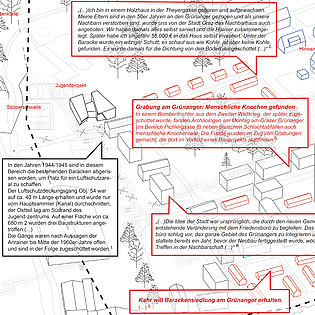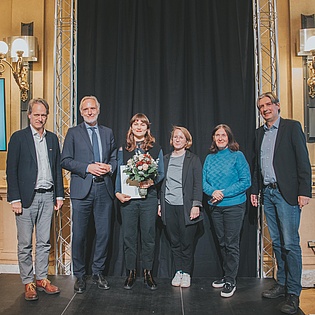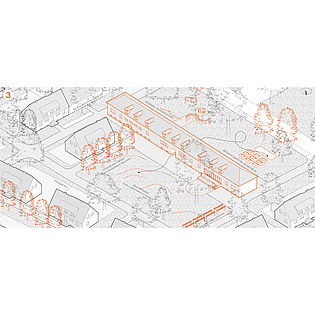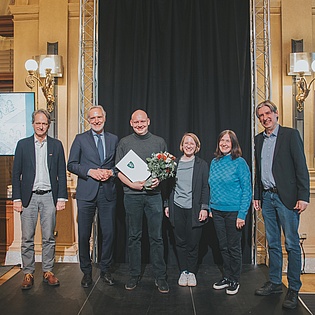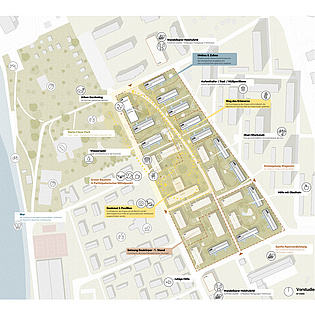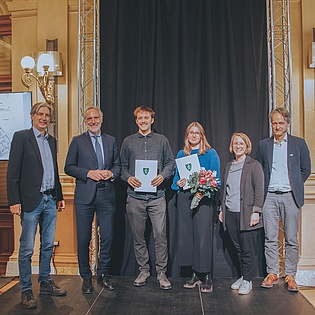“City, Meadow, River”: Herbert Eichholzer Awards 2023

The competition theme for this year’s Herbert Eichholzer Awards, under the title “Stadt, Anger, Fluss: Erinnerungskultur und Zukunft am Grünanger” (City, Meadow, River: Culture of Remembrance and the Future at the Grünanger), was to come up with concepts, strategies, and viewpoints for the future development of the Grünanger in Graz, a labor camp built in the historical context of World War II. Since the 1960s, the Grünanger has been repurposed as a small, densely built residential area with one- and twostory buildings. The site, located near a redesigned greenbelt recreational area on the Mur River, is now surrounded by high-density housing developments and urban structures.
The announced prizes were awarded by the City of Graz and the Faculty of Archi- tecture during a ceremony on November 23, 2023, in which Mayor Elke Kahr and City Councilman Günther Riegler also participated. The Herbert Eichholzer Award, which has been awarded biannually since 1992, the City of Graz and TU Graz, express their profound bond with Herbert Eichholzer and his work as an important representative of modern architecture in the interwar period and the resistance to National Socialism. The award was arranged and organized this year by the Chair of Architecture and Timber Construction (IATh).
1. Prize
The prizewinning project by Klara Schmidt and Siri Dacar concentrates on revealing the temporal and informational layers of the site and making history visible in urban space. This year’s jury, consisting of Daniel Gethmann (akk, TU Graz), Tom Kaden (IAT, Architektur und Holzbau, TU Graz), and Eva Hierzer (NOW Architektur, Graz), justified their decision as follows: “The project is convincing with a clear vision and strategy for a deliberate approach to the history of the place and its context without rebuilding in the classic sense. It presents a kind of processual perspective on creating a new culture of memory. The interventions took into account the existing residents and building fabric. The project adopted a clear stance, offered material for discussion, and provided stimuli for continuing reflection.”
2. Prize
The second prize of the Herbert Eichholzer Awards was given to Pia Pollak and Fabian Steinberger. Their project uses several targeted interventions to motivate social interaction among the residents of the neighborhood. Existing structures were used and, in some cases, adapted and supplemented. Focused renovation measures prevented demolition of existing buildings. The project focused on communication between residents and their surroundings. “A few modest interventions such as the market square, community center, and preservation of the existing youth century open,” according to the jury, “the neighborhood to the outside and encourage communication beyond the boundaries of the project.”
Recognition Award
The project of Ingo Candussi, Theresa Hammerl, and Daniel Lučić received the Recognition Award of this year’s Eichholzer Awards. Despite doubling the building density, their design offers a sensitive approach to outdoor areas and the placement of building volumes to preserve public areas and generate serene, framed, semiprivate areas. The residents and their participation are at the forefront of the project alongside the historical reappraisal. A path of remembrance leading though the neighborhood is intended to bring the history of the place to mind. The jury emphasized “the modest, phased development of the neighborhood that integrates local residents” as well as the design’s potential “for a heterogenous, lively neighborhood.”

